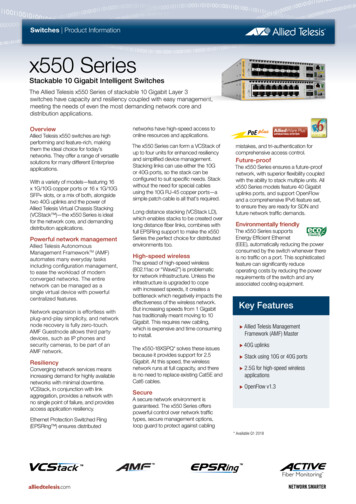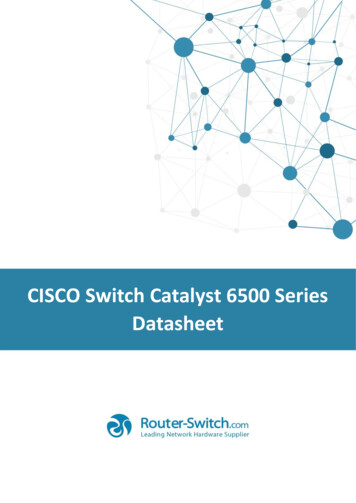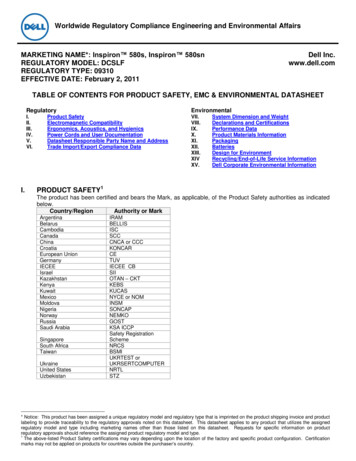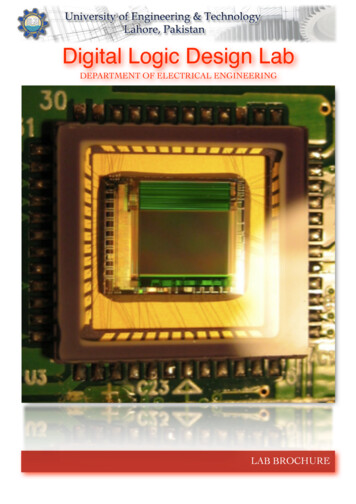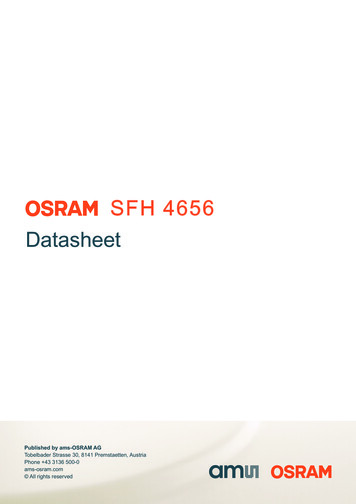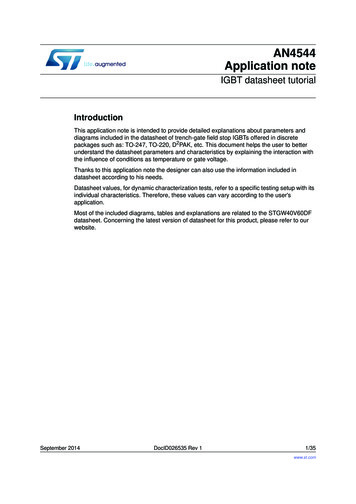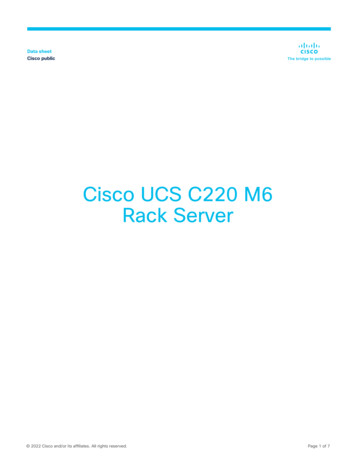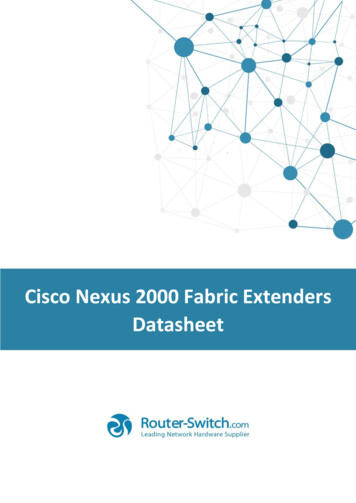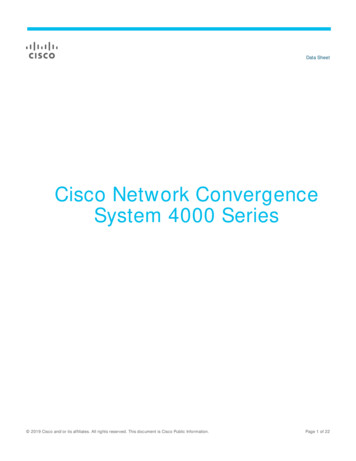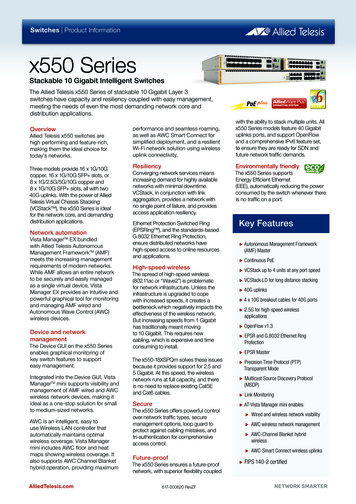
Transcription
Switches Product Informationx550 SeriesStackable 10 Gigabit Intelligent SwitchesThe Allied Telesis x550 Series of stackable 10 Gigabit Layer 3switches have capacity and resiliency coupled with easy management,meeting the needs of even the most demanding network core anddistribution applications.OverviewAllied Telesis x550 switches arehigh performing and feature-rich,making them the ideal choice fortoday’s networks.Three models provide 16 x 1G/10Gcopper, 16 x 1G/10G SFP slots, or8 x 1G/2.5G/5G/10G copper and8 x 1G/10G SFP slots, all with two40G uplinks. With the power of AlliedTelesis Virtual Chassis Stacking(VCStack ), the x550 Series is idealfor the network core, and demandingdistribution applications.Network automationVista ManagerTM EX bundledwith Allied Telesis AutonomousManagement FrameworkTM (AMF)meets the increasing managementrequirements of modern networks.While AMF allows an entire networkto be securely and easily managedas a single virtual device, VistaManager EX provides an intuitive andpowerful graphical tool for monitoringand managing AMF wired andAutonomous Wave Control (AWC)wireless devices.Device and networkmanagementThe Device GUI on the x550 Seriesenables graphical monitoring ofkey switch features to supporteasy management.Integrated into the Device GUI, VistaManagerTM mini supports visibility andmanagement of AMF wired and AWCwireless network devices, making itideal as a one-stop solution for smallto medium-sized networks.AWC is an intelligent, easy touse Wireless LAN controller thatautomatically maintains optimalwireless coverage. Vista Managermini includes AWC floor and heatmaps showing wireless coverage. Italso supports AWC Channel Blankethybrid operation, providing maximumperformance and seamless roaming,as well as AWC Smart Connect forsimplified deployment, and a resilientWi-Fi network solution using wirelessuplink connectivity.with the ability to stack multiple units. Allx550 Series models feature 40 Gigabituplinks ports, and support OpenFlowand a comprehensive IPv6 feature set,to ensure they are ready for SDN andfuture network traffic demands.ResiliencyEnvironmentally friendlyConverging network services meansincreasing demand for highly availablenetworks with minimal downtime.VCStack, in conjunction with linkaggregation, provides a network withno single point of failure, and providesaccess application resiliency.The x550 Series supportsEnergy Efficient Ethernet(EEE), automatically reducing the powerconsumed by the switch whenever thereis no traffic on a port.Ethernet Protection Switched Ring(EPSRing ), and the standards-basedG.8032 Ethernet Ring Protection,ensure distributed networks havehigh-speed access to online resourcesand applications.Key FeaturesHigh-speed wireless ۼ VCStack up to 4 units at any port speedThe spread of high-speed wireless(802.11ac or “Wave2”) is problematicfor network infrastructure. Unless theinfrastructure is upgraded to copewith increased speeds, it creates abottleneck which negatively impacts theeffectiveness of the wireless network.But increasing speeds from 1 Gigabithas traditionally meant movingto 10 Gigabit. This requires newcabling, which is expensive and timeconsuming to install. ۼ Autonomous Management Framework(AMF) Master ۼ Continuous PoE ۼ VCStack-LD for long distance stacking ۼ 40G uplinks ۼ 4 x 10G breakout cables for 40G ports ۼ 2.5G for high-speed wirelessapplications ۼ OpenFlow v1.3 ۼ EPSR and G.8032 Ethernet RingProtection ۼ EPSR MasterThe x550-18XSPQm solves these issuesbecause it provides support for 2.5 and5 Gigabit. At this speed, the wirelessnetwork runs at full capacity, and thereis no need to replace existing Cat5Eand Cat6 cables. ۼ Precision Time Protocol (PTP)Transparent ModeSecure ۼ AT-Vista Manager mini enables:The x550 Series offers powerful controlover network traffic types, securemanagement options, loop guard toprotect against cabling mistakes, andtri-authentication for comprehensiveaccess control.Future-proofThe x550 Series ensures a future-proofnetwork, with superior flexibility coupled617-000620 RevZF ۼ Multicast Source Discovery Protocol(MSDP) ۼ Link Monitoring ۼ Wired and wireless network visibility ۼ AWC wireless network management ۼ AWC-Channel Blanket hybridwireless ۼ AWC-Smart Connect wireless uplinks ۼ FIPS 140-2 certified
x550 Series Stackable 10 Gigabit Intelligent SwitchesKey FeaturesVista Manager mini ۼ Integrated into the Device GUI, Vista Managermini provides full network visibility of AMF wiredand AWC wireless devices. Manage and simplifywireless deployment with AWC-Smart Connect,and support optimal wireless performance fromAWC hybrid operation with maximum throughoutand a seamless Wi-Fi user experience.Allied Telesis AutonomousManagement FrameworkTM (AMF) ۼ Allied Telesis Autonomous ManagementFramework (AMF) is a sophisticated suite ofmanagement tools that provide a simplifiedapproach to network management. Powerfulfeatures like centralized management, autobackup, auto-upgrade, auto-provisioning andauto-recovery enable plug-and-play networkingand zero-touch management. ۼ Any x550 Series switch can operate as theAMF network master, storing firmware andconfiguration backups for other network nodes.The AMF master enables auto-provisioning andauto-upgrade by providing appropriate files tonew network members. New network devicescan be pre-provisioned making installation easybecause no on-site configuration is required. ۼ AMF Guestnode allows Allied Telesis wirelessaccess points and further switching products, aswell as third party devices such as IP phones andsecurity cameras, to be part of an AMF network.AWC Wireless Management ۼ Optimize wireless network performance with theAutonomous Wave Controller (AWC), built-in tothe x550 Series. AWC analyzes wireless trafficpatterns and automatically reconfigures accesspoints to meet demand. ۼ Wireless network operation in multi-channel,single-channel (Channel Blanket), and hybrid(multi-channel and Channel Blanket) modes,supports maximum data throughput andseamless roaming for the most flexible wirelesssolution available. ۼ AWC-Smart Connect (AWC-SC) enables plug-andplay wireless network growth, as new APsonly need a power connection, and will thenautomatically create resilient wireless uplinkconnections to other APs.Virtual Chassis Stacking (VCStackTM) ۼ Create a VCStack of up to four units with160Gbps of stacking bandwidth to each unit.Stacking links are connected in a ring so eachdevice has dual connections to further improveresiliency. VCStack provides a highly availablesystem where network resources are spread outacross stacked units, reducing the impact if oneof the units fails. Aggregating switch ports ondifferent units across the stack provides excellentnetwork resiliency.Long-DistanceStacking (VCStack-LD) ۼ Long-distance stacking allows a VCStack tobe created over longer distances, perfect for adistributed network environment.Flexible Deployment ۼ The compact x550-18XTQ and x550-18XSQenable easy deployment, and 2 units can be2 x550 Seriesinstalled side-by-side in 1RU, saving valuable rackspace. VCStack enables a single 32-port 1RUvirtual unit with built in resilience.Ethernet Protection SwitchedRing (EPSRingTM) ۼ EPSRing and 10 Gigabit Ethernet allow severalx550 switches to form high-speed protected ringscapable of recovery within as little as 50ms. Thisfeature is perfect for high performance and highavailability in enterprise networks. x550 Seriesswitches can act as the EPSR Master.G.8032 Ethernet Ring Protection ۼ G.8032 provides standards-based high-speedring protection, that can be deployed stand-alone,or interoperate with Allied Telesis EPSR. ۼ Ethernet Connectivity Fault Monitoring (CFM)proactively monitors links and VLANs, andprovides alerts when a fault is detected.Power over Ethernet Plus (PoE ) ۼ With PoE, a separate power connection to mediaendpoints such as IP phones and wireless accesspoints is not necessary. PoE reduces costsand provides even greater flexibility, providingthe capability to connect devices requiring morepower (up to 30 Watts) such as pan, tilt and zoomsecurity cameras.Continuous PoE ۼ Continuous PoE allows the switch to berestarted without affecting the supply of powerto connected devices. Smart lighting, securitycameras, and other PoE devices will continue tooperate during a software upgrade on the switch.Voice VLAN ۼ Voice VLAN automatically separates voiceand data traffic into two different VLANs. Thisautomatic separation places delay-sensitive trafficinto a voice- dedicated VLAN, which simplifiesQoS configurations.Open Shortest Path First (OSPFv3) ۼ OSPF is a scalable and adaptive routing protocolfor IP networks. The addition of OSPFv3 addssupport for IPv6 and further strengthens the AlliedTelesis focus on next generation networking.sFlow ۼ sFlow is an industry-standard technology formonitoring high-speed switched networks. Itprovides complete visibility into network use,enabling performance optimization, usageaccounting/billing, and defense against securitythreats. Sampled packets sent to a collector (upto 5 collectors can be configured) ensure it alwayshas a real-time view of network traffic.VLAN Mirroring (RSPAN) ۼ VLAN mirroring allows traffic from a port on aremote switch to be analyzed locally. Traffic beingtransmitted or received on the port is duplicatedand sent across the network on a special VLAN.Active Fiber Monitoring ۼ Active Fiber Monitoring prevents eavesdroppingon fiber communications by monitoring receivedoptical power. If an intrusion is detected, the linkcan be automatically shut down, or an operatoralert can be sent. Active Fiber Monitoring issupported on fiber data and fiber stacking links.Tri-authentication ۼ Authentication options on the x550 Series alsoinclude alternatives to IEEE 802.1x port-basedauthentication, such as web authentication, toenable guest access and MAC authenticationfor endpoints that do not have an IEEE 802.1xsupplicant. All three authentication methods—IEEE 802.1x, MAC-based and Web-based—can be enabled simultaneously on the sameport for tri-authentication.TACACS Command Authorization ۼ TACACS Command Authorization offerscentralized control over which commands maybe issued by each specific AlliedWare Plusdevice user. It complements authenticationand accounting services for a complete AAAsolution.Premium Software License ۼ By default, the x550 Series offers acomprehensive Layer 2 and basic Layer 3feature set that includes static routing and IPv6management features. The feature set caneasily be elevated to full Layer 3 by applying thepremium software license. This adds dynamicrouting protocols and Layer 3 multicastingcapabilities.VLAN Access Control List (ACLs) ۼ ACLs simplify access and traffic control acrossentire segments of the network. They can beapplied to a VLAN as well as a specific port.Software Defined Networking (SDN) ۼ OpenFlow is a key technology that enables theuse of SDN to build smart applications thatunlock value and reduce cost.Precision Time Protocol (PTP) ۼ PTP (IEEE 1588v2) sychronizes clocksthroughout the network with micro-secondaccuracy, supporting industrial automation andcontrol systems.Multi-speed Ports ۼ Copper ports on the x550-18XSPQm support 2.5and 5 Gigabit connectivity to enable high-speedwireless, and the use of legacy Cat5E/6 cabling.Multicast Source DiscoveryProtocol (MSDP) ۼ MSDP enables two or more PIM-SM (SparseMode) domains to share information on activemulticast sources, for more efficient forwardingof multicast traffic.Link Monitoring (Linkmon) ۼ Linkmon enables network health monitoringby regularly sending probes over key linksto gather metrics comprising latency, jitter,and probe loss. This supports pro-activenetwork management, and can also be usedwith triggers to automate a change to deviceor network configuration in response to thedeclining health of a monitored link.
x550 Series Stackable 10 Gigabit Intelligent SwitchesKey SolutionsNetwork SBL10x550 50x5 x530x250 50x5 x5ServerFarmNetworkAttachedSorage30x2VCStack link10 Gigabit link1 Gigabit link10/100 linkLink aggregationResilient distribution switchingAllied Telesis x550 Series switches are ideal fordistribution solutions, where resiliency and flexibility arerequired. In the above diagram, distribution switchesutilize long-distance Virtual Chassis Stacking (VCStackLD) to create a single virtual unit out of multiple devices.By using fiber stacking connectivity, units can bekilometers apart—perfect for a distributed environment.When combined with link aggregation, VCStack providesa solution with no single point of failure, and which fullyutilizes all available network bandwidth.x550 switches provide a resilient and reliable distributionsolution to support all networks with business-critical onlineresources and applications.x550 Series 3
x550 Series Stackable 10 Gigabit Intelligent SwitchesKey SolutionsResilient Network CoreEducation NetworkServersInternetMaster50 50x5 x5L30x5L30x5L30x5Staff andstudent devicesResilient network corex550 switches have the power of Virtual ChassisStacking (VCStack), which removes any single point offailure from the network—making them perfect for smallbusiness or education solutions.The diagram shows a pair of x550 switches in aneducation environment, with link aggregation betweenthe core VCStack and servers, the firewall, and edgeswitches to provide resilient connectivity.Allied Telesis edge switches connect and power accesspoints for wireless network connectivity for staff andstudents, as well as IP security cameras to ensure a safelearning environment.4 x550 Series10 Gigabit link1 Gigabit linkWAN linkLink aggregationAutonomous Management Framework (AMF) simplifies andautomates many day to day administration tasks, easingthe burden of network management. The x550 switchesact as the AMF master, automatically backing up the entirenetwork, and providing plug-and-play network growth andzero-touch unit replacement.Autonomous Wave Control (AWC) automatically optimizesthe wireless network to maximize performance, andminimize interference.Vista Manager mini provides integrated management of theAWC wireless network, with floor and heat maps enablingperformance monitoring.
x550 Series Stackable 10 Gigabit Intelligent SwitchesKey SolutionsIntegrated wireless LAN AttachedStorageServerRack50 50x5 x5erutRoInternet10 Gigabit link1 Gigabit linkWireless uplinkLink aggregationAllied Telesis Autonomous Wave Controller (AWC) offerssolutions for two of the most common problems withWireless LANs: initial setup complexity and on-goingperformance degradation. Initial WLAN set-up usuallyrequires a site survey to achieve the best coverage; andperformance of WLANs can often change over time asexternal sources of radio interference reduce coverageand bandwidth. These issues can be time-consuming toidentify and resolve.AWC features an intelligent process that automatically recalibrates the signal strength and radio channel of eachAccess Point (AP) for optimal WLAN performance.AWC Smart Connect (AWC-SC) uses wireless uplinkconnections between APs, so deployment is as easyas plugging in and powering on the new APs, whichautomatically extend the Wi-Fi network, creating aresilient solution.Vista Manager mini is integrated into the Device GUI ofthe x550 Series and provides an ideal solution for modernenterprise networks, enabling management of both thewired (with AMF) and wireless (with AWC) networks to beautomated. This reduces both the time and cost of networkadministration, as well as maximizing network performancefor a superior user experience.Up to 5 TQ Series wireless APs can be managed for free,and up to a further 40 APs (max 45) with feature licenses,available separately.On some AP models, hybrid channel blanket enables multichannel and single-channel WiFi operation simultaneously.This supports seamless roaming and maximum throughput.Channel Blanket licenses are available for up to 40 APs. Forplug-and-play wireless deployment AWC-SC licenses areavailable for up to 40 APs.x550 Series 5
x550 Series Stackable 10 Gigabit Intelligent SwitchesSpecificationsPRODUCT1G/10G (RJ-45)COPPER PORTS1G/2.5G/5G/10G (RJ-45)COPPER PORTS1G/10GSFP PORTS40G QSFP PORTSMAX POEENABLED PORTSSWITCHINGFABRICFORWARDING sPerformance ۼ 160Gbps of stacking bandwidth ۼ Supports L2 jumbo frames› 12.3KB at 1G, 10G, 40G› 6.5KB at 2.5G› 10.0KB at 5G ۼ Supports 9KB L3 jumbo frames ۼ Wirespeed multicasting ۼ 4094 configurable VLANs ۼ Up to 16K MAC addresses ۼ Up to 256 multicast entries ۼ Up to 128 Link Aggregation Groups (LAGS) - anycombination of static and dynamic (LACP) ۼ 1024MB DDR SDRAM, 1024MB flash memory ۼ Packet buffer memory: 4MBReliability ۼ Modular AlliedWare PlusTM operating system ۼ Full environmental monitoring of PSUs, fans,temperature and internal voltages. SNMP trapsalert network managers in case of any failurePower Characteristics ۼ AC voltage: 90 to 260V (auto-ranging) ۼ Frequency: 47 to 63HzExpandability ۼ Stack up to four units in a VCStack ۼ Premium license option for additional featuresFlexibility and Compatibility ۼ 10G SFP ports will support any combination ofAllied Telesis 1000Mbps SFP and 10GbE SFP modules and direct attach cables listed in thisdocument under Ordering Information ۼ Stacking ports can be configured from 10G or40G ports ۼ Port speed and duplex configuration can be setmanually or by auto-negotiationDiagnostic Tools ۼ Active Fiber Monitoring detects tampering onoptical links ۼ Built-In Self Test (BIST) ۼ Cable fault locator (TDR) ۼ Find-me device locator ۼ Automatic link flap detection and port shutdown ۼ Optical Digital Diagnostic Monitoring (DDM) ۼ Ping polling for IPv4 and IPv6 ۼ Port mirroring ۼ TraceRoute for IPv4 and IPv6 ۼ Uni-Directional Link Detection (UDLD)IPv4 Features ۼ Black hole routing ۼ Directed broadcast forwarding ۼ DNS relay ۼ Equal Cost Multi Path (ECMP) routing6 x550 Series ۼ Policy-based routing ۼ Route redistribution (OSPF, RIP, BGP) ۼ Static unicast and multicast routing for IPv4 ۼ UDP broadcast helper (IP helper)IPv6 Features ۼ DHCPv6 client and relay ۼ DNSv6 client and relay ۼ IPv4 and IPv6 dual stack ۼ IPv6 aware storm protection and QoS ۼ IPv6 hardware ACLs ۼ Device management over IPv6 networks with ۼ ۼ ۼ ۼ SNMPv6, Telnetv6 and SSHv6NTPv6 client and serverStatic unicast and multicast routing for IPv6Log to IPv6 hosts with Syslog v6IPv6 Ready certifiedManagement ۼ Front panel 7-segment LED provides at-a-glance ۼ ۼ ۼ ۼ ۼ ۼ ۼ ۼ ۼ ۼ status and fault informationAllied Telesis Autonomous ManagementFramework (AMF) enables powerful centralizedmanagement and zero-touch device installationand recoveryConsole management port on the front panel forease of accessEco-friendly mode allows ports and LEDs to bedisabled to save powerWeb-based Graphical User Interface (GUI)Industry-standard CLI with context-sensitive helpPowerful CLI scripting engineComprehensive SNMP MIB support for standardsbased device managementBuilt-in text editorEvent-based triggers allow user-defined scripts tobe executed upon selected system eventsUSB interface allows software release files,configurations and other files to be stored forbackup and distribution to other devicesQuality of Service ۼ 8 priority queues with a hierarchy of high priorityqueues for real time traffic, and mixed scheduling,for each switch port ۼ Limit bandwidth per port or per traffic class downto 64kbps ۼ Wirespeed traffic classification with low latencyessential for VoIP and real-time streaming mediaapplications ۼ IPv6 QoS support ۼ Policy-based QoS based on VLAN, port, MAC andgeneral packet classifiers ۼ Policy-based storm protection ۼ Extensive remarking capabilities ۼ Taildrop for queue congestion control ۼ Queue scheduling options for strict priority,weighted round robin or mixed scheduling ۼ Type of Service (ToS) IP precedence and DiffServmarking based on layer 2, 3 and 4 headersResiliency Features ۼ Control Plane Prioritization (CPP) ensures the CPU ۼ ۼ ۼ ۼ ۼ ۼ ۼ ۼ always has sufficient bandwidth to process networkcontrol trafficDynamic link failover (host attach)EPSRing (Ethernet Protection Switched Rings) withSuperLoop Protection (SLP) and enhanced recoveryfor extra resiliencyFlexi-stacking - use any port speed to stack: 10Gfiber, 10G copper or 40G fiberLong-Distance VCStack over fiber with 10G SFP modules or 40G QSFP modules (LD-VCStack)Loop protection: loop detection and thrash limitingPVST compatibility modeSTP root guardVCStack fast failover minimizes network disruptionSecurity Features ۼ Federal Information Processing StandardPublication 140-2 (FIPS 140-2) certified ۼ Access Control Lists (ACLs) based on layer 3 and4 headers ۼ ACL Groups enable multiple hosts/ports to beincluded in a single ACL, reducing configuration ۼ Auth fail and guest VLANs ۼ Authentication, Authorisation and Accounting(AAA) ۼ Bootloader can be password protected for devicesecurity ۼ BPDU protection ۼ DHCP snooping, IP source guard and DynamicARP Inspection (DAI) ۼ DoS attack blocking and virus throttling ۼ Dynamic VLAN assignment ۼ MAC address filtering and MAC address lockdown ۼ Network Access and Control (NAC) featuresmanage endpoint security ۼ Learn limits (intrusion detection) for single ports orLAGs ۼ Private VLANs provide security and port isolationfor multiple customers using the same VLAN ۼ Secure Copy (SCP) ۼ Secure File Transfer Protocol (SFTP) client ۼ Strong password security and encryption ۼ Tri-authentication: MAC-based, web-based andIEEE 802.1x ۼ Web-based authenticationSoftware Defined Networking ۼ OpenFlow v1.3 including support for connectioninterruption, control plane encryption andinactivity probeEnvironmental Specifications ۼ Operating temperature range:0 C to 45 C (32 F to 113 F)Derated by 1 C per 305 meters (1,000 ft) ۼ Storage temperature range:-25 C to 70 C (-13 F to 158 F)
x550 Series Stackable 10 Gigabit Intelligent Switches ۼ Certification: UL, cUL, TUV, FIPS 140-2 ۼ EMC: EN55022 class A, FCC class A, VCCI class ۼ Operating relative humidity range:A, ICES-003 class A ۼ Immunity: EN55024, EN61000-3-levels 2(Harmonics), and 3 (Flicker) – AC models only5% to 90% non-condensing ۼ Storage relative humidity range:5% to 95% non-condensing ۼ Operating altitude:3,048 meters maximum (10,000 ft)Restrictions on HazardousSubstances (RoHS) Compliance ۼ EU RoHS compliant ۼ China RoHS compliantSafety ۼ Standards: UL60950-1, CAN/CSA-C22.2 No.60950-1-03, EN60950-1, EN60825-1, AS/NZS60950.1Electrical Approvalsand CompliancesPhysical SpecificationsPRODUCTWIDTHDEPTHHEIGHTWEIGHT210 mm (8.3 in)346 mm (13.6 in)44 mm (1.7 in)3.1 kg (6.85 lb)x550-18XSQ210 mm (8.3 in)346 mm (13.6 in)44 mm (1.7 in)3.2 kg (7.00 lb)x550-18XSPQm440 mm (17.3 in)260 mm (10.2in)44 mm (1.7 in)4.2 kg (9.15 lb)x550-18XTQPower CharacteristicsNO POE LOADPRODUCTFULL POE LOADNOISEMAX POWERCONSUMPTIONMAX HEATDISSIPATIONNOISEMAX POEPOWERMAX POE PORTSAT 30W PER PORT436 BTU/h50 dBA-----111W378 BTU/h46 dBA-----99W338 BTU/h47 dBA391W1334 BTU/h47 dBA240W8MAX POWERCONSUMPTIONMAX mLatency (Microseconds)PORT µs3.0µs2.3µsStandards and ProtocolsAlliedWare Plus Operating SystemVersion 5.5.1-2AuthenticationRFC 1321RFC 1828MD5 Message-Digest algorithmIP authentication using keyed MD5Border Gateway Protocol (BGP)BGP dynamic capabilityBGP outbound route filteringRFC 1772 Application of the Border Gateway Protocol(BGP) in the InternetRFC 1997 BGP communities attributeRFC 2385 Protection of BGP sessions via the TCP MD5signature optionRFC 2439 BGP route flap dampingRFC 2545 Use of BGP-4 multiprotocol extensions forIPv6 inter-domain routingRFC 2858 Multiprotocol extensions for BGP-4RFC 2918 Route refresh capability for BGP-4RFC 3392 Capabilities advertisement with BGP-4RFC 3882 Configuring BGP to block Denial-of-Service(DoS) attacksRFC 4271 Border Gateway Protocol 4 (BGP-4)RFC 4360 BGP extended communitiesRFC 4456 BGP route reflection - an alternative to fullmesh iBGPRFC 4724 BGP graceful restartRFC 4893RFC 5065BGP support for four-octet AS number spaceAutonomous system confederations for BGPCryptographic AlgorithmsFIPS Approved AlgorithmsEncryption (Block Ciphers): ۼ AES (ECB, CBC, CFB and OFB Modes) ۼ 3DES (ECB, CBC, CFB and OFB Modes)Block Cipher Modes: ۼ CCM, CMAC, GCM, XTSIEEE 802.3ab1000BASE-TIEEE 802.3ae 10 Gigabit EthernetIEEE 802.3af Power over Ethernet (PoE)IEEE 802.3an 10GBASE-TIEEE 802.3at Power over Ethernet Plus (PoE )IEEE 802.3az Energy Efficient Ethernet (EEE)IEEE 802.3ba 40GBASE-XIEEE 802.3bz 2.5GBASE-T and 5GBASE-TIEEE 802.3x Flow control - full-duplex operationIEEE 802.3z 1000BASE-XIEEE 1588v2 Precision clock synchronization protocol v2Digital Signatures & Asymmetric Key Generation: ۼ DSA, ECDSA, RSASecure Hashing: ۼ SHA-1 ۼ SHA-2 (SHA-224, SHA-256, SHA-384. SHA-512)Message Authentication: ۼ HMAC (SHA-1, SHA-2(224, 256, 384, 512)Random Number Generation: ۼ DRBG (Hash, HMAC and Counter)Non FIPS Approved AlgorithmsRNG (AES128/192/256)DESMD5EthernetIEEE 802.2 Logical Link Control (LLC)IEEE 802.3 EthernetIPv4 FeaturesRFCRFCRFCRFCRFCRFC768791792793826894RFC 919RFC 922RFC 932RFC 950RFC 951RFC 1027RFC 1035RFC 1042User Datagram Protocol (UDP)Internet Protocol (IP)Internet Control Message Protocol (ICMP)Transmission Control Protocol (TCP)Address Resolution Protocol (ARP)Standard for the transmission of IPdatagrams over Ethernet networksBroadcasting Internet datagramsBroadcasting Internet datagrams in thepresence of subnetsSubnetwork addressing schemeInternet standard subnetting procedureBootstrap Protocol (BootP)Proxy ARPDNS clientStandard for the transmission of IPdatagrams over IEEE 802 networksx550 Series 7
x550 Series Stackable 10 Gigabit Intelligent SwitchesRFC 1071RFC 1122RFC 1191RFC 1256RFC 1518RFC 1519RFC 1542RFC 1591RFC 1812RFC 1918RFC 2581Computing the Internet checksumInternet host requirementsPath MTU discoveryICMP router discovery messagesAn architecture for IP address allocation withCIDRClassless Inter-Domain Routing (CIDR)Clarifications and extensions for BootPDomain Name System (DNS)Requirements for IPv4 routersIP addressingTCP congestion controlRFC 3636RFC 4022RFC 4113RFC 4188RFC 4292RFC 4293RFC 4318RFC 4560RFC 5424RFC 6527IEEE 802.3 MAU MIBMIB for the Transmission Control Protocol(TCP)MIB for the User Datagram Protocol (UDP)Definitions of managed objects for bridgesIP forwarding table MIBMIB for the Internet Protocol (IP)Definitions of managed objects for bridgeswith RSTPDefinitions of managed objects for remoteping, traceroute and lookup operationsSyslog protocolDefinitions of managed objects for VRRPv3IPv6 FeaturesRFC 1981RFC 2460RFC 2464RFC 2711RFC 3484RFC 3587RFC 3596RFC 4007RFC 4193RFC 4213RFC 4291RFC 4443RFC 4861RFC 4862RFC 5014RFC 5095RFC 5175RFC 6105Path MTU discovery for IPv6IPv6 specificationTransmission of IPv6 packets over EthernetnetworksIPv6 router alert optionDefault address selection for IPv6IPv6 global unicast address formatDNS extensions to support IPv6IPv6 scoped address architectureUnique local IPv6 unicast addressesTransition mechanisms for IPv6 hosts androutersIPv6 addressing architectureInternet Control Message Protocol (ICMPv6)Neighbor discovery for IPv6IPv6 Stateless Address Auto-Configuration(SLAAC)IPv6 socket API for source address selectionDeprecation of type 0 routing headers in IPv6IPv6 Router Advertisement (RA) flags optionIPv6 Router Advertisement (RA) guardManagementAMF MIB and SNMP trapsAT Enterprise MIBSNMPv1, v2c and v3IEEE 802.1ABLink Layer Discovery Protocol (LLDP)RFC 1155 Structure and identification of managementinformation for TCP/IP-based InternetsRFC 1157 Simple Network Management Protocol(SNMP)RFC 1212 Concise MIB definitionsRFC 1213 MIB for network management of TCP/IP-based Internets: MIB-IIRFC 1215 Convention for defining traps for use with theSNMPRFC 1227 SNMP MUX protocol and MIBRFC 1239 Standard MIBRFC 1724 RIPv2 MIB extensionRFC 2578 Structure of Management Information v2(SMIv2)RFC 2579 Textual conventions for SMIv2RFC 2580 Conformance statements for SMIv2RFC 2674 Definitions of managed objects for bridgeswith traffic classes, multicast filtering andVLAN extensionsRFC 2741 Agent extensibility (AgentX) protocolRFC 2787 Definitions of managed objects for VRRPRFC 2819 RMON MIB (groups 1,2,3 and 9)RFC 2863 Interfaces group MIBRFC 3176 sFlow: a method for monitoring traffic inswitched and routed networksRFC 3411 An architecture for describing SNMPmanagement frameworksRFC 3412 Message processing and dispatching for theSNMPRFC 3413 SNMP applicationsRFC 3414 User-based Security Model (USM) forSNMPv3RFC 3415 View-based Access Control Model (VACM)for SNMPRFC 3416 Version 2 of the protocol operations for theSNMPRFC 3417 Transport mappings for the SNMPRFC 3418 MIB for SNMPRFC 3635 Definitions of managed objects for theEthernet-like interface types8 x550 SeriesMulticast SupportBootstrap Router (BSR) mechanism for PIM-SMIGMP query solicitationIGMP snooping (IGMPv1, v2 and v3)IGMP snooping fast-leaveIGMP/MLD multicast forwarding (IGMP/MLD proxy)MLD snooping (MLDv1 and v2)PIM for IPv6 and PIM SSM for IPv6RFC 1112 Host extensions for IP multicasting (IGMPv1)RFC 2236 Internet Group Management Protocol v2(IGMPv2)RFC 2710 Multicast Listener Discovery (MLD) for IPv6RFC 2715 Interoperability rules for multicast routingprotocolsRFC 3306 Unicast-prefix-based IPv6 multicastaddressesRFC 3376 IGMPv3RFC 3618 Multicast Source Discovery Protocol (MSDP)RFC 3810 Multicast Listener Discovery v2 (MLDv2) forIPv6RFC 3956 Embedding the Rendezvous Point (RP)address in an IPv6 multicast a
Open Shortest Path First (OSPFv3) ۼ OSPF is a scalable and adaptive routing protocol for IP networks. The addition of OSPFv3 adds support for IPv6 and further strengthens the Allied Telesis focus on next generation networking. sFlow ۼ sFlow is an industry-standard technology for monitoring high-speed switched networks. It
